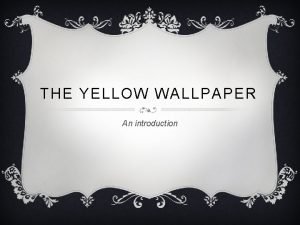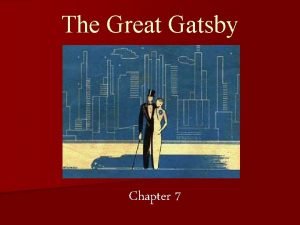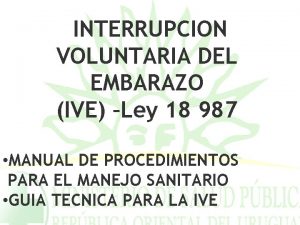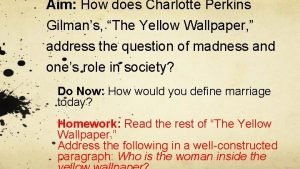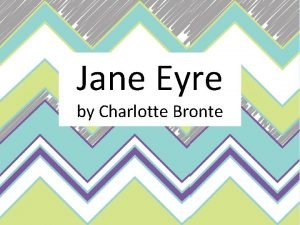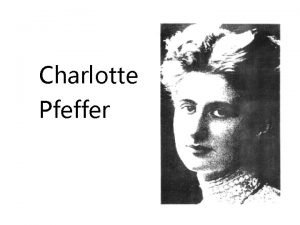IVE GOT OUT AT LAST CHARLOTTE PERKINS GILMANS










- Slides: 10

“I’VE GOT OUT AT LAST!”: CHARLOTTE PERKINS GILMAN’S CRITIQUE OF THE MISDIAGNOSIS OF HYSTERIA IN “THE YELLOW WALLPAPER” By Mandy Potter

“THE YELLOW WALLPAPER” BY CHARLOTTE PERKINS GILMAN v. Published in 1892 v. Characters v. The female narrator- unnamed to allow reader to put themselves in the narrator’s place. v. John-narrator’s physician husband v. Jane/Jennie/Mary-John’s sisters, narrator’s caretaker, main name used is Jennie but others appear v. Gothic genre v. Psychological Realism v. Feminist Writing

THE STORY BEHIND “THE YELLOW WALLPAPER” v 19 th Century-Women were v. Key term of madness- achieving credibility for their Narrator is not crazy: she chose to be free and society works and writing about saw that as madness topics that truly mattered. v“Model of literary history is v. It “was not intended to drive intensely (even exclusively) people crazy, but to save male, and necessarily people from being driven patriarchal” (Gilbert 47). crazy, and it worked” (“Why I Wrote The Yellow Wallpaper”).

THESIS “By looking at reviews of the work, statements about the Rest Cure and hysteria, and Gilman’s own personal story, one can see that “The Yellow Wallpaper” criticized the mistreatment of women’s health and offered a voice to the women being mistreated. ”

THE STORY OF “THE YELLOW WALLPAPER” v. Format and language allowed readers to be in the room with the narrator v. Triumphant ending v“’I've got out at last, ’ said I, ‘in spite v. Written in a journal for all to see of you and Jane’” (“The Yellow v. Wallpaper was deemed “a potential Wallpaper” 656). mental health hazard for women, v. Gilman “knew the cure for female children, and convalescents in despair must be spirited as well restricted environment. ” (Thomas) physical, aesthetic as well as social” (Gilbert 92).

RECEPTION OF “THE YELLOW WALLPAPER” v The New England Magazine was the first to publish Gilman’s story. v Men upset about it: believed it would give women ideas v Believed to be too dark and graphic for the public v Editor of magazine had a friend going through similar situation and the story helped cure her (Dock 88).

CRITICAL RESPONSE v“Escaping the Jaundiced Eye”- John S. Bak v. He believed the story ended in real madness and that the narrator was “reduced to a paranoid schizophrenic” (Bak 44).

THE STORY CHANGES MEDICINE v. Dr. S. Weir Mitchell’s Rest Cure v. Treatment for “hysteria”, which is now known to have been postpartum depression v“Local treatment, ” a four-part process that included manual investigations, leeching, injections, and cauterizations (Wood 30). v. In the text: v “There comes John, and I must put this away, - he hates to have me write a word” (649) v“John says if I don't pick up faster he shall send me to Weir Mitchell in the fall” (650)

CONCLUSIONS v“The Yellow Wallpaper” demonstrated that it was not women who were mad, but society who was mad in its harsh expectation of perfection they had for women. The story started a conversation about the misdiagnosis and mistreatment of women and their health. v. Publishing company-Potter and Potter Presswork; Boston, Massachusetts

WORKS CITED o¹Bak, John S. “Escaping the jaundiced eye: Foucauldian Panopticism in Charlotte Perkins Gilman's "The Yellow Wallpaper. "” Studies in Short Fiction 31. 1 (1994): 39 -45. Web. 12 Oct. 2015 o²Dock, Julie Bates. The Yellow Wallpaper and the History of Its Publication and Reception: A Critical Edition. Pennsylvania: The Pennsylvania University Press, 1998. Print. o¹Gilbert, Sandra M. , and Susan Gubar. The Madwoman in the Attic: The Woman Writer and the Nineteenthcentury Literary Imagination. New Haven: Yale UP, 1979. Print. o²Gilman, Charlotte Perkins. “Why I Wrote The Yellow Wallpaper [sic]. ” The Forerunner Oct. 1913. American Literature Since 1865. University of Virginia, n. d. Web. 12 Oct. 2015. o²Gilman, Charlotte Perkins. "The Yellow Wallpaper. " New England Magazine 11. 5 (Jan. 1892): 647 -57. Making of America. Cornell University Library. Web. 15 Sept. 2015. o. Golden, Catherine J. The Yellow Wallpaper: A Sourcebook and Critical Edition. New York: Routledge, 2004. Web. 7 Oct. 2015 o. Schumaker, Conrad. “Too Terribly Good to Be Printed. ” American Literature 57. 4 (1985): 588 - 599. Web. 24 September 2015. o¹Thomas, Heather Kirk. "'[A] Kind of Debased Romanesque with Delirium Tremens': Late-Victorian Wall Coverings and Charlotte Perkins Gilman's 'The Yellow Wallpaper. '. " The Mixed Legacy of Charlotte Perkins Gilman. Ed. Catherine J. Golden and Joanna Schneider Zangrando. Newark: University of Delaware Press, 2000. 189 -206. Rpt. in Short Story Criticism. Ed. Janet Witalec. Vol. 62. Detroit: Gale, 2003. Literature Resource Center. Web. 15 Sept. 2015. o²Wood, Ann Douglas. “The Fashionable Diseases: Women’s complaints and Their Treatment in Nineteenth. Century America. ” Journal of Interdisciplinary History 4. 1 (1973): 25. 52. JSTOR. Web. 24 Sept. 2015.
 Lately i been i been losing sleep
Lately i been i been losing sleep Charlotte perkins gilman
Charlotte perkins gilman The great gatsby summary chapter 7
The great gatsby summary chapter 7 Family friends 2 unit 1
Family friends 2 unit 1 Present simple exercises pre intermediate
Present simple exercises pre intermediate Sta je present simple
Sta je present simple Figurative language in the song one thing by one direction
Figurative language in the song one thing by one direction Drunk sex quotes
Drunk sex quotes Last year i got a puzzle as a birthday
Last year i got a puzzle as a birthday The narrator says she got out her curling irons
The narrator says she got out her curling irons Que es el ive
Que es el ive

